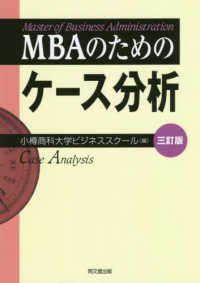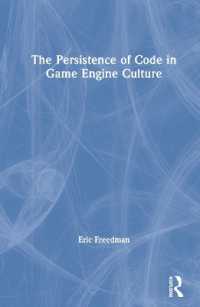- ホーム
- > 洋書
- > 英文書
- > Science / Mathematics
Full Description
During July and August of 1976 a group of 90 physicists from 56 laboratories in 21 countries met in Erice for the 14th Course of the International School of Subnuclear Physics. The countries represented were Argentina, Australia, Austria, Belgium, Denmark, the Federal Republic of Germany, France, the German Democratic Republic, Greece, Israel, Italy, Japan, Mexico, Nigeria, Norway, Sweden, the United Kingdom, the United States of America, Vietnam, and Yugoslavia. The School was sponsored by the Italian Ministry of Public Education (MPI), the Italian Ministry of Scientific and Technological Research (MRST), the North Atlantic Treaty Organi zation (NATO), the Regional Sicilian Government (ERS), and the Weizmann Institute of Science. The program of the School was mainly devoted to the elucida tion and discussion of the progress achieved in the theoretical and experimental understanding of the fundamental constituents of matter. On the theoretical front we had a series of remarkable lecturers (C. N. Yang, S. Weinberg, G. C. Wick) attempting a description of finite size particles. Another group of lecturers covered such topics as the understanding of the new particles (H. J. Lipkin), whether or not jets really exist (E. Lillethun), and the unexpected A-dependence of massive dileptons produced in high-energy proton- nucleus collisions (J. W. Cronin). Two other outstanding questions were covered by E. Leader and G. Preparata respectively: whether strong interactions are still within the Regge framework, and if it is really possible to master strong interactions. A. J. S.
Contents
Theoretical Lectures.- Critical Phenomena for Field Theorists.- Monopoles and Fiber Bundles.- Three Lectures on Solitons.- Can We Ever Understand Hadronic Matter? A Proposal.- Can Pedestrians Understand the New Particles?.- Are Strong Interactions Still Within the Regge Framework?.- Hadronization of Quark Theories.- Phenomenology of Neutral—Current Interactions.- Review Lectures.- Weak Currents and New Quarks.- Review of Massive Dilepton Production in Proton-Nucleus Collisions.- Are Jets Really There.- Characteristics of ??e+Ko Events Produced by a Neutrino Beam.- Hadron Physics at FERMILAB.- A Review of the ISR Results.- The Highlights of the Tbilisi Conference.- Seminars on Specialized Topics.- Hadron Nucleus Collisions in the Collective Tube Model.- Production of Dimuons by Pions and Protons at FERMILAB.- Physics with the Single Arm Spectrometer at FERMILAB.- Azimuthal Correlations in Particle Production at Low P?.- Monopoles.- Quarks, Color and Octonions.- Field Theory Approach to the Statistical Bootstrap.- Closing Lecture.- Fifty Years of Symmetry Operators.- Closing Ceremony.- List of Participants.








